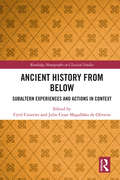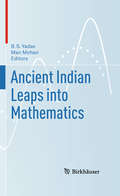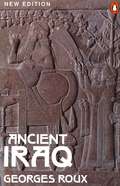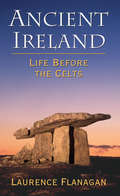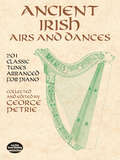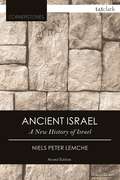- Table View
- List View
Ancient History from Below: Subaltern Experiences and Actions in Context (Routledge Monographs in Classical Studies)
by Cyril Courrier Julio Cesar Magalhães De OliveiraIf ancient history is particularly susceptible to a top-down approach, due to the nature of our evidence and its traditional exploitation by modern scholars, another ancient history—‘from below’—is actually possible. This volume examines the possibilities and challenges involved in writing it. Despite undeniable advances in recent decades, ‘our slowness to reconstruct plausible visions of almost any aspect of society beyond the top-most strata of wealth, power or status’ (as Nicholas Purcell has put it) remains a persistent feature of the field. Therefore, this book concerns a historical field and social groups that are still today neglected by modern scholarship. However, writing ancient history ‘from below’ means much more than taking into account the anonymous masses, the subaltern classes and the non-elites. Our task is also, in the felicitous expression coined by Walter Benjamin, ‘to brush history against the grain,’ to rescue the viewpoint of the subordinated, the traditions of the oppressed. In other words, we should understand the bulk of ancient populations in light of their own experience and their own reactions to that experience. But, how do we do such a history? What sources can we use? What methods and approaches can we employ? What concepts are required to this endeavour? The contributions mainly engage with questions of theory and methodology, but they also constitute inspiring case studies in their own right, ranging from classical Greece to the late antique world. This book is aimed not only at readers working on classical Greece, republican and imperial Rome and late antiquity but at anyone interested in ‘bottom-up’ history and social and population history in general. Although the book is primarily intended for scholars, it will also appeal to graduate and undergraduate students of history, archaeology and classical studies.
Ancient History from Coins (Approaching the Ancient World)
by Christopher HowgegoLike other volumes in this series, Ancient History from Coins demystifies a specialism, introducing students (from first year upwards) to the techniques, methods, problems and advantages of using coins to do ancient history.Coins are a fertile source of information for the ancient historian; yet too often historians are uneasy about using them as evidence because of the special problems attaching to their interpretation. The world of numismatics is not always easy for the non-specialist to penetrate or understand with confidence. Dr Howgego describes and anlyses the main contributions the study of coins can make to ancient history, showing shows through numerous examples how the character, patterns and behaviour of coinage bear on major historical themes. Topics range from state finance and economic policy to imperial domination and political propaganda through coins types.The period covered by the book is from the invention of coinage (ca 600BC) to AD 400.
Ancient History from Coins (Approaching the Ancient World)
by Christopher HowgegoLike other volumes in this series, Ancient History from Coins demystifies a specialism, introducing students (from first year upwards) to the techniques, methods, problems and advantages of using coins to do ancient history.Coins are a fertile source of information for the ancient historian; yet too often historians are uneasy about using them as evidence because of the special problems attaching to their interpretation. The world of numismatics is not always easy for the non-specialist to penetrate or understand with confidence. Dr Howgego describes and anlyses the main contributions the study of coins can make to ancient history, showing shows through numerous examples how the character, patterns and behaviour of coinage bear on major historical themes. Topics range from state finance and economic policy to imperial domination and political propaganda through coins types.The period covered by the book is from the invention of coinage (ca 600BC) to AD 400.
The Ancient History of the Near East: From the Earliest Times to the Battle of Salamis (Routledge Revivals)
by H.R. HallThe ancient history of Greece holds a great deal of interest to many, particularly to those whose culture and religion grew from early Greek civilisation. Originally published in 1913, Hall provides a thorough history of the origins of Ancient Greek civilisation as well as commenting on Egypt, Syria, Palestine and Babylon amongst others. This title will be of interest to students of Classics and Ancient History.
The Ancient History of the Near East: From the Earliest Times to the Battle of Salamis (Routledge Revivals)
by H.R. HallThe ancient history of Greece holds a great deal of interest to many, particularly to those whose culture and religion grew from early Greek civilisation. Originally published in 1913, Hall provides a thorough history of the origins of Ancient Greek civilisation as well as commenting on Egypt, Syria, Palestine and Babylon amongst others. This title will be of interest to students of Classics and Ancient History.
Ancient Indian Leaps into Mathematics
by B. S. Yadav and Man MohanB.S. Yadav and Man MohanThis book presents contributions of mathematicians covering topics from ancient India, placing them in the broader context of the history of mathematics. Although the translations of some Sanskrit mathematical texts are available in the literature, Indian contributions are rarely presented in major Western historical works. Yet some of the well-known and universally-accepted discoveries from India, including the concept of zero and the decimal representation of numbers, have made lasting contributions to the foundation of modern mathematics. Through a systematic approach, this book examines these ancient mathematical ideas that were spread throughout India, China, the Islamic world, and Western Europe.
The Ancient Indus Valley: New Perspectives (Understanding Ancient Civilizations)
by Jane R. McIntoshThis work is a revealing study of the enigmatic Indus civilization and how a rich repertoire of archaeological tools is being used to probe its puzzles.The Ancient Indus Valley: New Perspectives takes readers back to a civilization as complex as its contemporaries in Mesopotamia and Egypt, one that covered a far larger region, yet lasted a much briefer time (less than a millennium) and left few visible traces.Researchers have tentatively reconstructed a model of Indus life based on limited material remains and despite its virtually indecipherable written record. This volume describes what is known about the roots of Indus civilization in farming culture, as well as its far-flung trading network, sophisticated crafts and architecture, and surprisingly war-free way of life. Readers will get a glimpse of both a remarkable piece of the past and the extraordinary methods that have brought it back to life.
Ancient Iraq (Pelican Bks.)
by Georges RouxBook provides an introduction to the history of ancient Mesopotamia and its civilizations, incorporating archaeological and historical finds up to 1992
Ancient Ireland: Life Before the Celts
by Laurence FlanaganWhen the Celts first arrived in Ireland around 200 B.C., the island had already been inhabited for over 7000 years. Drawing on a wealth of archaeological evidence and the author's own mastery of the subject, Ancient Ireland returns to those pre-Celtic roots in a bid to discover the secrets of the island's first inhabitants: Who were they? And how did they live? Few accounts of the period are as exhaustively researched; fewer still are as alive with historical insight and compelling detail. At once accessible and comprehensive, Ancient Ireland is an indispensable guide to early Irish civilisation, its culture and mythology.
Ancient Irish Airs and Dances: 201 Classic Tunes Arranged for Piano
by George PetrieFrom the tender "My heart's love is he" to the bitter "Hag, you've killed me," this extraordinary compilation of melodies ranks among the most important 19th-century collections of traditional Irish music. Out of print for many years, these selections have become extremely rare and sought-after items.
Ancient Israel: A New History of Israel (T&T Clark Cornerstones)
by Niels Peter LemcheWhen this provocative text was first published, Lemche presented a new model of how we should understand Israelite society, its history and its religion. Lemche argues first that 'Israel' was the result of a social development among the Canaanite population of Palestine in the second half of the second millennium BCE. This implies that Israelite religion was originally 'Canaanite' and that what we think of as typically 'Jewish' religion did not arise until c. 500 BCE. Lemche's radical reassessment of Israelite history is based on the conviction that the Old Testament contains hardly any historical sources older than the seventh century BCE. The early history of Israel must therefore be reconstructed from archaeological results and non-biblical evidence, not from the Old Testament. In this new edition Lemche provides an extensive new introduction and bibliography, considering how the field has developed since the work first appeared.
Ancient Israel: A New History of Israel (T&T Clark Cornerstones #139)
by Niels Peter LemcheWhen this provocative text was first published, Lemche presented a new model of how we should understand Israelite society, its history and its religion. Lemche argues first that 'Israel' was the result of a social development among the Canaanite population of Palestine in the second half of the second millennium BCE. This implies that Israelite religion was originally 'Canaanite' and that what we think of as typically 'Jewish' religion did not arise until c. 500 BCE. Lemche's radical reassessment of Israelite history is based on the conviction that the Old Testament contains hardly any historical sources older than the seventh century BCE. The early history of Israel must therefore be reconstructed from archaeological results and non-biblical evidence, not from the Old Testament. In this new edition Lemche provides an extensive new introduction and bibliography, considering how the field has developed since the work first appeared.
Ancient Israel at War 853–586 BC (Guide to... #67)
by Brad KelleComplex and unstable, in 922 BC the kingdom of Ancient Israel was divided into Judah, in the South, and Israel, in the North. For the next 200 years, there was almost constant warring between these kingdoms and their neighbors. These bitter feuds eventually led to the collapse of Israel, leaving Judah as a surviving nation until the emergence of the Babylonian Empire, the destruction of Jerusalem in 586 BC, and the exile of the Judean people. Using ancient Jewish, Biblical, and other contemporary sources, this title examines the politics, fighting, and consequences of Israel's battles during this period. Focusing on the turbulent relationship between the kingdoms of Israel and Judah, this book explains Israel's complex, often bloody, foreign policy, and provides a definitive history of these ancient conflicts.
Ancient Israel in Sinai: The Evidence for the Authenticity of the Wilderness Tradition
by James K. HoffmeierIn his pathbreaking Israel in Egypt James K. Hoffmeier sought to refute the claims of scholars who doubt the historical accuracy of the biblical account of the Israelite sojourn in Egypt. Analyzing a wealth of textual, archaeological, and geographical evidence, he put forth a thorough defense of the biblical tradition. Hoffmeier now turns his attention to the Wilderness narratives of Exodus, Leviticus, and Numbers. As director of the North Sinai Archaeological Project, Hoffmeier has led several excavations that have uncovered important new evidence supporting the Wilderness narratives, including a major New Kingdom fort at Tell el-Borg that was occupied during the Israelite exodus. Hoffmeier employs these archaeological findings to shed new light on the route of the exodus from Egypt. He also investigates the location of Mount Sinai, and offers a rebuttal to those who have sought to locate it in northern Arabia and not in the Sinai peninsula as traditionally thought. Hoffmeier addresses how and when the Israelites could have lived in Sinai, as well as whether it would have been possible for Moses to write down the law received at Mount Sinai. Building on the new evidence for the Israelite sojourn in Egypt, Hoffmeier explores the Egyptian influence on the Wilderness tradition. For example, he finds Egyptian elements in Israelite religious practices, including the use of the tabernacle, and points to a significant number of Egyptian personal names among the generation of the exodus. The origin of Israel is a subject of much debate and the wilderness tradition has been marginalized by those who challenge its credibility. In Ancient Israel in Sinai, Hoffmeier brings the Wilderness tradition to the forefront and makes a case for its authenticity based on solid evidence and intelligent analysis.
The Ancient Israelite World (Routledge Worlds)
by Kyle H. KeimerThis volume presents a collection of studies by international experts on various aspects of ancient Israel’s society, economy, religion, language, culture, and history, synthesizing archaeological remains and integrating them with discussions of ancient Near Eastern and biblical texts. Driven by theoretically and methodologically informed discussions of the archaeology of the Iron Age Levant, the 47 chapters in The Ancient Israelite World provide foundational, accessible, and detailed studies in their respective topics. The volume considers the history of interpretation of ancient Israel, studies on various aspects of ancient Israel’s society and history, and avenues for present and future approaches to the ancient Israelite world. Accompanied by over 150 maps and figures, it allows the reader to gain an understanding of key issues that archaeologists, historians and biblical scholars have faced and are currently facing as they attempt to better understand ancient Israelite society. The Ancient Israelite World is an essential reference work for students and scholars of ancient Israel and its history, culture, and society, whether they are historians, archaeologists or biblical scholars.
The Ancient Israelite World (Routledge Worlds)
by Kyle H. Keimer George A. PierceThis volume presents a collection of studies by international experts on various aspects of ancient Israel’s society, economy, religion, language, culture, and history, synthesizing archaeological remains and integrating them with discussions of ancient Near Eastern and biblical texts. Driven by theoretically and methodologically informed discussions of the archaeology of the Iron Age Levant, the 47 chapters in The Ancient Israelite World provide foundational, accessible, and detailed studies in their respective topics. The volume considers the history of interpretation of ancient Israel, studies on various aspects of ancient Israel’s society and history, and avenues for present and future approaches to the ancient Israelite world. Accompanied by over 150 maps and figures, it allows the reader to gain an understanding of key issues that archaeologists, historians and biblical scholars have faced and are currently facing as they attempt to better understand ancient Israelite society. The Ancient Israelite World is an essential reference work for students and scholars of ancient Israel and its history, culture, and society, whether they are historians, archaeologists or biblical scholars.
Ancient Israel's Neighbors (Essentials of Biblical Studies)
by Brian R. DoakWhether on a national or a personal level, everyone has a complex relationship with their closest neighbors. Where are the borders? How much interaction should there be? How are conflicts solved? Ancient Israel was one of several small nations clustered in the eastern Mediterranean region between the large empires of Egypt and Mesopotamia in antiquity. Frequently mentioned in the Bible, these other small nations are seldom the focus of the narrative unless they interact with Israel. The ancient Israelites who produced the Hebrew Bible lived within a rich context of multiple neighbors, and this context profoundly shaped Israel. Indeed, it was through the influence of the neighboring people that Israel defined its own identity-in terms of geography, language, politics, religion, and culture. Ancient Israel's Neighbors explores both the biblical portrayal of the neighboring groups directly surrounding Israel-the Canaanites, Philistines, Phoenicians, Edomites, Moabites, Ammonites, and Arameans-and examines what we can know about these groups through their own literature, archaeology, and other sources. Through its analysis of these surrounding groups, this book will demonstrate in a direct and accessible manner the extent to which ancient Israelite identity was forged both within and against the identities of its close neighbors. Animated by the latest and best research, yet written for students, this book will invite readers into journey of scholarly discovery to explore the world of Israel's identity within its most immediate ancient Near Eastern context.
ANCIENT ISRAEL'S NEIGHBORS EBS C (Essentials of Biblical Studies)
by Brian R. DoakWhether on a national or a personal level, everyone has a complex relationship with their closest neighbors. Where are the borders? How much interaction should there be? How are conflicts solved? Ancient Israel was one of several small nations clustered in the eastern Mediterranean region between the large empires of Egypt and Mesopotamia in antiquity. Frequently mentioned in the Bible, these other small nations are seldom the focus of the narrative unless they interact with Israel. The ancient Israelites who produced the Hebrew Bible lived within a rich context of multiple neighbors, and this context profoundly shaped Israel. Indeed, it was through the influence of the neighboring people that Israel defined its own identity-in terms of geography, language, politics, religion, and culture. Ancient Israel's Neighbors explores both the biblical portrayal of the neighboring groups directly surrounding Israel-the Canaanites, Philistines, Phoenicians, Edomites, Moabites, Ammonites, and Arameans-and examines what we can know about these groups through their own literature, archaeology, and other sources. Through its analysis of these surrounding groups, this book will demonstrate in a direct and accessible manner the extent to which ancient Israelite identity was forged both within and against the identities of its close neighbors. Animated by the latest and best research, yet written for students, this book will invite readers into journey of scholarly discovery to explore the world of Israel's identity within its most immediate ancient Near Eastern context.
Ancient Jewish Novels: An Anthology
by Lawrence M. WillsThis volume brings together for the first time all of the ancient Jewish novels and fragments of novels. Written at about the same time as the Dead Sea Scrolls and the New Testament, but before the period of Rabbinic Judaism, these texts reveal the ambiguities and conflicts encountered by Jews in this period.
Ancient Law, Ancient Society (Law And Society In The Ancient World Ser.)
by Dennis P. Kehoe Thomas McGinnThe essays composing Ancient Law, Ancient Society examine the law in classical antiquity both as a product of the society in which it developed and as one of the most important forces shaping that society. Contributors to this volume consider the law via innovative methodological approaches and theoretical perspectives—in particular, those drawn from the new institutional economics and the intersection of law and economics. Essays cover topics such as using collective sanctions to enforce legal norms; the Greek elite’s marriage strategies for amassing financial resources essential for a public career; defenses against murder charges under Athenian criminal law, particularly in cases where the victim put his own life in peril; the interplay between Roman law and provincial institutions in regulating water rights; the Severan-age Greek author Aelian’s notions of justice and their influence on late-classical Roman jurisprudence; Roman jurists’ approach to the contract of mandate in balancing the changing needs of society against respect for upper-class concepts of duty and reciprocity; whether the Roman legal authorities developed the law exclusively to serve the Roman elite’s interests or to meet the needs of the Roman Empire’s broader population as well; and an analysis of the Senatus Consultum Claudianum in the Code of Justinian demonstrating how the late Roman government adapted classical law to address marriage between free women and men classified as coloni bound to their land. In addition to volume editors Dennis P. Kehoe and Thomas A. J. McGinn, contributors include Adriaan Lanni, Michael Leese, David Phillips, Cynthia Bannon, Lauren Caldwell, Charles Pazdernik, and Clifford Ando.
Ancient Legends, Mystic Charms and Superstitions of Ireland
by Jane WildeLady Jane Wilde was the mother of Oscar Wilde and an accomplished folklorist. She sought to preserve Irish culture through recording their enchanting myths, rituals and beliefs. This collection contains over 100 of these enthralling tales, from fairies stealing children to leprechauns promising gold. Each showcase the strange and mystical superstitions spread by Irish peasantry in the ancient tongue.Tales include:• The Horned Women• The Fenian Knights• The Fairy Changeling• The Legends of the Western IslandsThis edition includes a chapter on the ancient peoples of Ireland written by her husband Sir William Wilde which forms part of the original manuscript. Accompanying the text are beautiful illustrations by Stephen Reid from The High Deeds of Finn and a rare map of ancient Ireland.
Ancient Legends Retold: The Legend Of Pryderi (Ancient Legends Retold Ser.)
by Fiona CollinsThe Four Branches of the Mabinogion are a rich treasure trove of tales. These magical, quintessentially Welsh stories are confusing, but it would be hard to match their splendid strangeness. The Four Branches tell of the kings and queens of Wales in the time of’ ‘Once upon a time’. Only one character appears in all Four Branches. He is Pryderi, and the story of his life journey is told in this book. Pryderi is brave and bold: sometimes foolhardy, always fiercely loyal. The stories of two beautiful, powerful women entwine with his: Rhiannon of the Birds, his mother, and Cigfa, his wife. Both accompany him on his life path. But, at the last, Pryderi must go on alone. Here, for the first time, his tale is told from beginning to end.
Ancient Legends Retold: Tales Of Robin Hood, The Five Early Ballads (Ancient Legends Retold Ser.)
by Michael DacreThis collection of five tales and one play contains the definitive Robin Hood. They are the earliest ballads and play and still the best of the bunch. ‘Robin Hood and the Monk’ is the earliest surviving manuscript, dated c.1450, and is considered the greatest of the ballads, though it was probably not sung, being described as a ‘talkyng’; ‘Robin Hood’s Death’ is one of the most satisfying tragedies in the English language; while ‘A Lytell Geste of Robyn Hode’ is a comprehensive account of the famous English outlaw - complete, unified and pointing quite clearly to the reign of Edward II as a probable time for an historical Robin Hood, despite the opinions of most of the experts.
Ancient Legends Retold: Vortigern - Early King Of The Britons (Ancient Legends Retold Ser.)
by Simon Heywood'My name is Vortigern ... ' Generations before Arthur's birth, a British warlord looks back on his life: his rise from humble roots to shake the thrones of a dying empire; his stand against chaos amid the aftermath of Rome; his struggle with the greedy, embittered princes of church and kingdom; his loves and his losses, and his last encounter with his own mysterious destiny, on a mountain where the world we know is beginning to take shape before his eyes. Vortigern's voice speaks from the heart of a forgotten darkness, telling a story of courage and cowardice, glory and crime, tragedy and treason.
Ancient Legends Retold: Arthur's Knights and the Ladies of the Lake (Ancient Legends Retold Ser.)
by Bernard Kelly June PetersAround the round table there was always one seat which remained empty. This was the place left for the knight who would one day attain the Grail and restore the land. This mysterious piece of furniture, the Seat Perilous, has been part of Arthurian myth for a 1,000 years. It was the original hot seat – if you sat there and were not the one, you would be consumed by fire. These are the untold tales of the knights who went out into the world and the ladies of the lake they found there. This book follows them into an unknown interior where they encounter the Queen of the Wasteland and through her story, return with the greatest prize of all.
